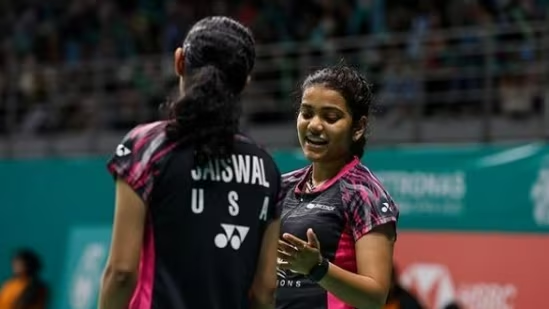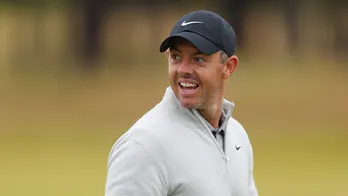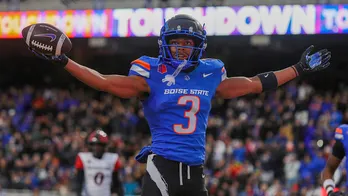From Boston to Hyderabad to back in the US: Srivedya leaves India in quest for Olympics
Born in Boston. Trained in India. Appeared in Indian colours, but it all changed for Srivedya Gurazada in October last year, when she decided to switch to the United States.

When a 19-year-old Gurazada turned up at the 2022 India Open, she still had the Indian tricolour beside her name. Gurazada had partnered Ishika Jaiswal of the US, making a rare badminton doubles combination of two players hailing from different countries. In fact, Gurazada and Jaiswal were the only pairing of such kind across all doubles categories at the India Open in the last edition. This year, the count for the same was back to zero as Gurazada officially represented the USA.
The pair had a good start to the year at the Malaysia Open – its first Super 750 tournament – where it defeated a much senior Spanish duo of Clara Azurmendi and Beatriz Corrales in three games. In New Delhi, however, Gurazada and Jaiswal were drawn with third-seeded pair Kim So Yeong and Kong Hee-yong of South Korea; the young duo lost 9-21, 10-21. But at this stage of her career, Gurazada is happy to take on the players from higher rankings and accumulating a wealth of experience.
Talking to Hindustan Times in an exclusive chat during the India Open, Gurazada opens up on why she made the switch, the challenges of playing badminton in the United States, and targets for this year:
How was the experience of playing at the India Open this year?
It was really good. It's the second time I'm playing at the India Open, but the last time when I was here, there were no fans. This is the first-time playing India Open with the crowd. It's a different feeling. Even though I have played (with fans) in the US, I'm fortunate to have played in front of the home crowd.
Tell us about your switch to the United States. What prompted the decision?
It happened in around October 2022. I made the switch because I was born in Boston, that makes me a US citizen. And we shifted to India when I was 3-4 years old. I started playing badminton in India and I trained at the Chetan Anand academy. He asked me to play some tournaments in India, so I started playing here. But the thing is, I can't represent India at the Olympics. I don't hold the citizenship, so that's why I made the switch. It will help me in the Olympic qualification.
When I was playing for India, I didn’t get to practice with the Indian team. There were times we were practicing (with Indian players) during the tournaments, but not so much. The thing is, even though I played for India, I sparred rarely with the Indian team.
Also read: 'Translating motivation into medals': Satwik-Chirag eye breaking into top-3 after stellar 2022
The switch, specifically to the US, must be a big change for you…
When I shifted to the US, it wasn’t the same. Even though I was an independent player in India, I did have players sparring with us once in a while. When I shifted to the US… the standards of the Indian players are absurd. When you compare them, you feel there’s a difference. We try to practice in the academy in India, she (Jaiswal) comes to the academy and we train here. But then again, there’s a difference between sparring with local players and the national players. That’s where we find the huge gap.
Did you consider applying for an Indian citizenship?
“No. I wanted to move back to the US at some point in my life. There’s some politics too, you don’t see it on the surface but it’s there in the system. There’s politics in the US too, it’s everywhere essentially, but here, since there are a lot of people, you can visibly see it.
Badminton isn’t quite as popular in the US as it is in India. How hard was it to adapt?
I've been practicing and staying in India even though I've been playing for the US. I played some tournaments at the Pan-American circuit as well. In US, we don't have a team. When we travel, we find ourselves playing on individual sponsorships. They cover all of our expenses. We have an association but we don't have a team, so it's a little difficult for us to spar with other players because it's only the two-three of us.
So, I think that is a flaw in the system. Like in India, we have 10,000 players fighting. We don't have that sort of quantity in the US.
Your partner Ishika Jaiswal has been playing with the US since the beginning of her career, but you’ve partnered with her even while you were representing India. How did you two start playing together?
I played the junior nationals in 2019. She played too. We played against each other and she won against me and my partner. After that, Covid happened. In 2021, she reached out to me asking whether I’d play with her in tournaments and try to work things out. I was already playing in the tournaments she proposed and that’s how we started playing. In some tournaments where I didn’t play with her, I played with Poorvisha (S. Ram). She gave me a heads up in advance for that.
View this post on InstagramA post shared by Srivedya Gurazada🌸 (@srivedya_gurazada1)
You went to second round at the Malaysia Open last week. Your doubles ranking is 34 at the moment. What are your targets this year?
I'd say the target for now is to break into top-20. Play better, perform better, and go to the top-20. Win some challengers in 100s maybe, and slowly get to the next level. We do feel there's a gap because we don't practice together. She lives in the US and I live in India. There's a gap, and obviously there's a difference in singles and doubles practice. But I do feel confident that we will do well.
Are you planning on shifting to US at some point?
Maybe. I see myself doing that. Maybe not now, but in two or three years.
Also read: Viktor Axelsen lauds 'tricky opponent' Srikanth after first round win at India Open
Did you have interactions with players from Indian team when you played here?
I didn't have much of an interaction with them team because I wasn't the part of the team during all India events as well. I was an independent player. I did had conversation with N Sikki Reddy and Ashwini Ponnappa when we played in Indonesia. It was very beneficial. One senior player who helped me a lot with exposure is Poorvisha S Ram (former world no.30). When I played in Cameroon and Bangalore with her, I learnt a lot on how I should act on court. She keeps talking to me about how to turn a bad day into a good day. We are still in touch and she has been a support system for me.
You also play in singles. What do you find most comfortable?
I play doubles more freely than singles but I enjoy playing both of them. As long as I can play singles, I will do that. I would like to play in big tournaments but my ranking wouldn't let me get into those for now. I'll play in the 100s and I hope to break into the 750 as well. I'm planning on playing the challengers and the 200s as well.
Who did you idolize growing up?
My idol is my coach, Chetan Anand. Ever since I started badminton, I have played under him. He remains calm and composed on the court and that's something to learn. Because it's very difficult to not show emotions on the court. Normally, as a woman's player, I idolize Carolina (Marin). I admire her aggression and determination to make comebacks even on her bad days.
What’s next for you after India Open?
"We have sent an entry to the German Open. So, if we get into the tournament, it will be the Germany and then, All England.
Disclaimer: The copyright of this article belongs to the original author. Reposting this article is solely for the purpose of information dissemination and does not constitute any investment advice. If there is any infringement, please contact us immediately. We will make corrections or deletions as necessary. Thank you.







